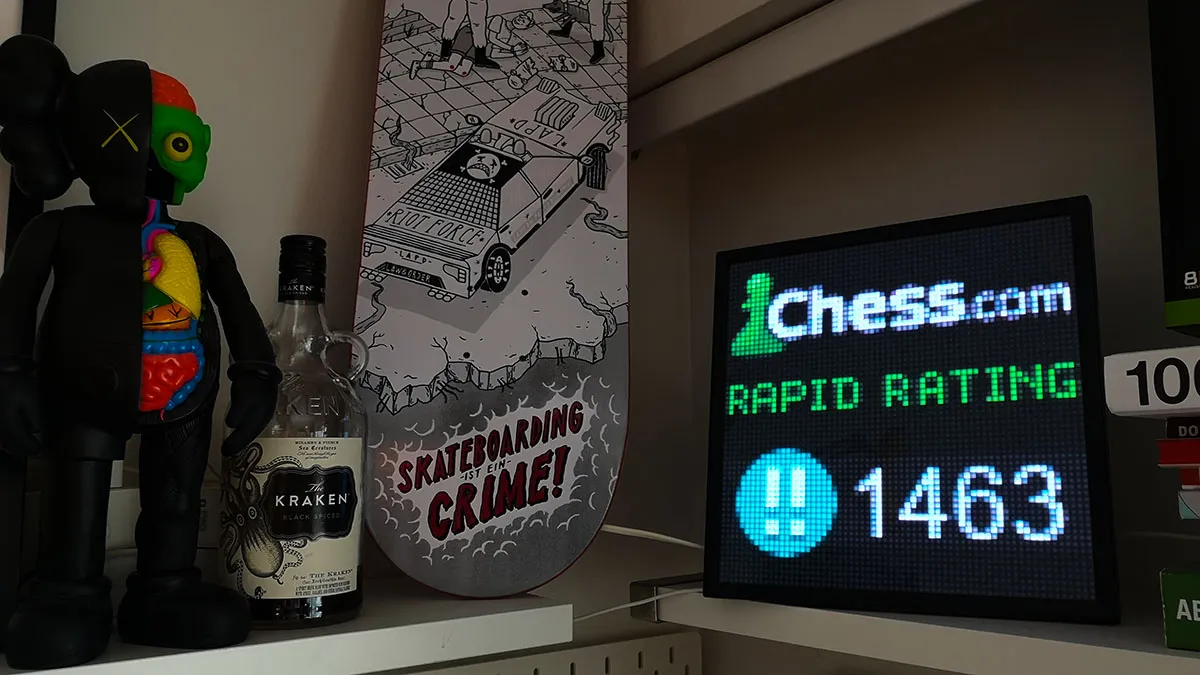Welcome to an in-depth exploration of my latest project: a real-time chess rating display using Python, the Chess.com API, and a Pixoo display. This project is not just a fusion of technology and chess but also an expression of how hobbies can inspire innovative creations.
Inspiration
As a chess enthusiast and a coding hobbyist, I wanted to merge these two areas in a unique way. The idea struck me after a thrilling online chess match on Chess.com - why not have a live display of my chess rating, something I could glance at and feel motivated by?
The Goal
The objective was clear: create a device that fetches my real-time chess rating from Chess.com and displays it on a Pixoo screen, a versatile and customizable LED display.
Fetching Chess Stats
Chess.com API Integration
I started by exploring the Chess.com API, which provides various endpoints to fetch user data. The endpoint /pub/player/{username}/stats was particularly useful for fetching user statistics, including ratings for different game formats.
Sample Code for Fetching Chess Stats
import requests
def fetch_chess_stats(username):
url = f"https://api.chess.com/pub/player/{username}/stats"
headers = {"User-Agent": "YourApp"}
response = requests.get(url, headers=headers)
return response.json() if response.status_code == 200 else NoneDisplaying on Pixoo
Now that we have our Pixoo setup ready, let’s display some text on it. We’ll keep it simple for now and just display the word “test” on the Pixoo simulator window.
Challenges
While developing this project, I encountered several challenges that tested my problem-solving skills and deepened my understanding of the technologies involved. Some of the challenges I faced include:
-
Environment Setup: Setting up the development environment, including installing necessary packages and configuring environment variables, was a bit tricky initially. However, with some research and experimentation, I was able to overcome this challenge.
-
API Integration: Integrating with the Chess.com API to fetch user statistics posed a challenge due to the need for authentication and understanding the structure of the API responses. I had to carefully read the API documentation and handle authentication tokens to successfully retrieve the required data.
-
Image Rendering: Rendering text onto an image and displaying it on the Pixoo device required careful consideration of font size, text placement, and image dimensions. I had to experiment with different font sizes and positions to achieve the desired result.
-
Simulator Testing: Testing the application using the Pixoo simulator presented challenges in accurately simulating the device’s behavior and ensuring compatibility with the actual hardware. I had to iterate on the code and simulate various scenarios to validate its functionality.
 The final look of our Chess Rating Display on a Pixoo screen.
The final look of our Chess Rating Display on a Pixoo screen.
Conclusion
In conclusion, developing the Chess.com Pixoo project was an enriching experience that allowed me to explore the integration of hardware devices with web APIs. I learned valuable lessons about environment setup, API integration, image rendering, and simulator testing. Despite encountering challenges along the way, I persevered and successfully implemented the desired functionality.
Moving forward, I plan to further enhance the project by adding additional features, such as real-time data updates, interactive user interfaces, and support for different types of content. I’m excited to continue exploring the intersection of hardware and software development and leveraging technology to create innovative solutions.
Stay tuned for updates on the Chess.com Pixoo project, and feel free to reach out with any questions or feedback. Happy coding!